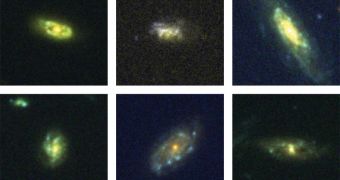A group of scientists was finally able to figure out why galaxies appear capable to form new stars even if they no longer have the necessary supplies of hydrogen gas. The team found a galaxy that is currently recycling already-used materials, putting it to work again.
This discovery explains how galaxies seemingly depleted of star-forming materials can continue to produce blue stars even as they grow extremely old. This discrepancy could not be accounted for until now, astronomers explain.
The galactic recycling theory was proposed quite some time ago, but no evidence was ever obtained to support this proposition. The new study was the first to identify large masses of gas flowing into distant galaxies, contributing directly to the formation of blue stars, Space reports.
One issue that always made astronomers wonder was whether the amount of gas expelled from galaxies during supernova events, or when new stars were emerging from their cocoons, were irremediably lost to the cosmic structures.
In other words, the question was whether galaxies had sufficient mass to exert a gravitational force large enough to reclaim the lost gas, even if the hydrogen masses were expelled at great velocities.
The answer appears to be yes, the new study demonstrates. This means that galaxies including the Milky Way may continue to form new stars even two billion years from now, when hydrogen gas reserves are expected to be entirely depleted.
Astronomers explain that our galaxy is not an exception, but rather the norm among spiral galaxies.
“This is a key piece of the puzzle and important evidence that cosmic recycling ('galactic fountains') could indeed solve the mystery of the missing raw matter,” a statement released by scientists at the Max Planck Institute for Astronomy (MPIA) explains.
The MPIA team, led by astronomer Kate Rubin, used the Keck I telescope on Mauna Kea in Hawaii to collect the data necessary for this research. A total of 100 galaxies were surveyed during the study. These objects were located between 5 and 8 billion light-years away.
Six of these galaxies revealed telltale signs that they were reabsorbing hydrogen gas they had previously released during stellar formation and supernova explosions, Space reports.

 14 DAY TRIAL //
14 DAY TRIAL //